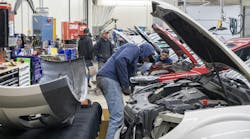Seeing the Bigger Picture
I recently conducted a peanut butter and jelly sandwich test with the team at one of our locations. This is a great learning and team-building exercise about communication, perceptions and assumptions that exist in the workplace. The exercise blends humor with poignant lessons on the causes and consequences of communication breakdown (If you’ve never seen it, YouTube has several examples).
We talked a lot about how our communication failures could negatively impact our customers and, of course, the team had several good answers and insights about that. Thinking the time was right, I asked, “What do you think is our purpose as a company? And as a team, why do we come to work each day, and ultimately who do we serve?” Having ignored the lesson that you shouldn’t ask a question that you don’t already know the answer to, I was still surprised when one of the key members of the team said, “I come to work to make a living.”
This response was quite an eye opener for me because it demonstrated a disconnect between our company vision and purpose and that of the individual who gave the response. In thinking about how the disconnect occurred, I was reminded of a valuable leadership lesson that I learned from Peter Drucker, who used elements of the Three Stonecutters fable to relate his lesson:
“One day a traveler walking along a lane came across three stonecutters working in a quarry. Each was busy cutting a block of stone. Interested to find out what they were working on, he asked the first stonecutter what he was doing. 'I am cutting a stone,' he said. Still no wiser, the traveler turned to the second stonecutter and asked him what he was doing. 'I am cutting this block of stone to make sure that it’s square, and its dimensions are uniform, so that it will fit exactly in its place in a wall,' he said. A bit closer to finding out what the stonecutters were working on but still unclear, the traveler turned to the third stonecutter. He seemed to be the happiest of the three and when asked what he was doing replied: ’I am building a cathedral.’”
The third stonecutter had a visionary outlook on his work, even though what he did as an occupation was the same as the other stonecutters. He had the ability to look beyond the obvious and he certainly seems to be genuinely happy about his work.
But is he demonstrating a leadership quality? My belief is that he has not achieved that level yet because the other two stonecutters do not share his vision of the work. Peter Senge, another management guru, has explained, “the responsibility of a leader is not just to share a vision, but to build a shared vision.”
How do we begin the process of creating a shared vision within our organizations? First is that the owners and leaders of the company must create and publish a company mission and purpose statement, and augment it with a list of core values and beliefs.
A mission statement is a short sentence or concise paragraph that defines what the organization is, why it exists, and its purpose. These declarations should include the company goals for its customers, its employees and its owners. These goals are typically long term and change little over the life of the organization.
At my company, we have the following mission statement: “We will expand our business by earning the long term loyalty of our customers and employees with our passion for excellence. Working to deliver more than promised; being honest and fair and going the extra mile to provide exceptional personalized service." Our purpose statement, meanwhile, is “to provide the best quality and value in auto body repair in the markets we service and to enable our employees and shareholders to flourish and prosper.”
If you don’t already have a mission statement, you can plan to spend many hours contemplating what your statement should contain. You may want to collaborate with some of the key people in your organization and incorporate some of their thoughts and ideas about your mission. No matter what path you take, in the end, the statement must be uniquely yours and must truly capture the purpose for existence of your company.
I believe that creating a list of core values and beliefs goes a long way toward developing the culture of your company. Culture is sometimes defined as the habits and patterns of response that a group reverts to when handling problems that come up between themselves, their customers and others outside of their environment. We seek to create a culture where behaviors that become the norm are closely aligned with the behaviors that owners and leaders would expect. Culture determines what is right and wrong, what is acceptable or unacceptable, and what is important or unimportant.
Having a set of core values and beliefs becomes the de facto standard that employees will refer to when making decisions within your business, even when you aren’t looking. Think of it as “this is how we do things around here.”
At Pride Collision Centers, we have developed a list of 10 core values and beliefs. Here are a few examples:
- We feel a sense of urgency on any matters related to our customers. We own problems and we are always responsive. We are customer driven.
- We require complete honesty and integrity in everything we do.
- We are believers in the Golden Rule. In all our dealings we will strive to be friendly and courteous, as well as fair and compassionate.
Thinking back to the stonecutters fable, I certainly would love to have a whole team full of “cathedral builders” and it is clear to me that some of the most important work we can do inside of our business is building a shared vision. I know I still have work to do.




